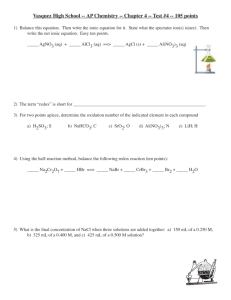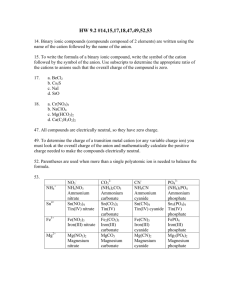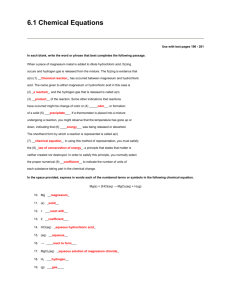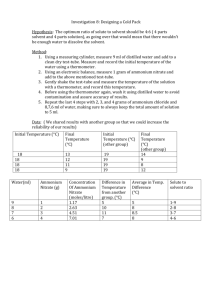arch.2004.doc
advertisement
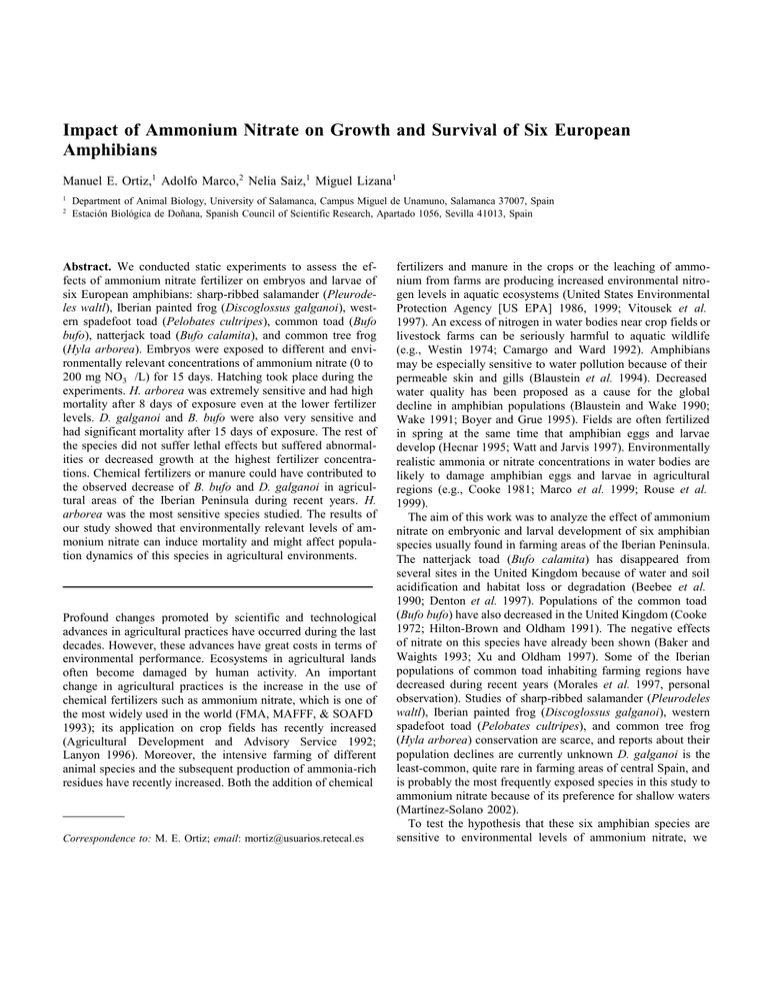
Impact of Ammonium Nitrate on Growth and Survival of Six European Amphibians Manuel E. Ortiz,1 Adolfo Marco,2 Nelia Saiz,1 Miguel Lizana1 1 2 Department of Animal Biology, University of Salamanca, Campus Miguel de Unamuno, Salamanca 37007, Spain Estación Biológica de Doñana, Spanish Council of Scientific Research, Apartado 1056, Sevilla 41013, Spain Abstract. We conducted static experiments to assess the effects of ammonium nitrate fertilizer on embryos and larvae of six European amphibians: sharp-ribbed salamander (Pleurodeles waltl), Iberian painted frog (Discoglossus galganoi), western spadefoot toad (Pelobates cultripes), common toad (Bufo bufo), natterjack toad (Bufo calamita), and common tree frog (Hyla arborea). Embryos were exposed to different and environmentally relevant concentrations of ammonium nitrate (0 to 200 mg NO3 /L) for 15 days. Hatching took place during the experiments. H. arborea was extremely sensitive and had high mortality after 8 days of exposure even at the lower fertilizer levels. D. galganoi and B. bufo were also very sensitive and had significant mortality after 15 days of exposure. The rest of the species did not suffer lethal effects but suffered abnormalities or decreased growth at the highest fertilizer concentrations. Chemical fertilizers or manure could have contributed to the observed decrease of B. bufo and D. galganoi in agricultural areas of the Iberian Peninsula during recent years. H. arborea was the most sensitive species studied. The results of our study showed that environmentally relevant levels of ammonium nitrate can induce mortality and might affect population dynamics of this species in agricultural environments. Profound changes promoted by scientific and technological advances in agricultural practices have occurred during the last decades. However, these advances have great costs in terms of environmental performance. Ecosystems in agricultural lands often become damaged by human activity. An important change in agricultural practices is the increase in the use of chemical fertilizers such as ammonium nitrate, which is one of the most widely used in the world (FMA, MAFFF, & SOAFD 1993); its application on crop fields has recently increased (Agricultural Development and Advisory Service 1992; Lanyon 1996). Moreover, the intensive farming of different animal species and the subsequent production of ammonia-rich residues have recently increased. Both the addition of chemical Correspondence to: M. E. Ortiz; email: mortiz@usuarios.retecal.es fertilizers and manure in the crops or the leaching of ammonium from farms are producing increased environmental nitrogen levels in aquatic ecosystems (United States Environmental Protection Agency [US EPA] 1986, 1999; Vitousek et al. 1997). An excess of nitrogen in water bodies near crop fields or livestock farms can be seriously harmful to aquatic wildlife (e.g., Westin 1974; Camargo and Ward 1992). Amphibians may be especially sensitive to water pollution because of their permeable skin and gills (Blaustein et al. 1994). Decreased water quality has been proposed as a cause for the global decline in amphibian populations (Blaustein and Wake 1990; Wake 1991; Boyer and Grue 1995). Fields are often fertilized in spring at the same time that amphibian eggs and larvae develop (Hecnar 1995; Watt and Jarvis 1997). Environmentally realistic ammonia or nitrate concentrations in water bodies are likely to damage amphibian eggs and larvae in agricultural regions (e.g., Cooke 1981; Marco et al. 1999; Rouse et al. 1999). The aim of this work was to analyze the effect of ammonium nitrate on embryonic and larval development of six amphibian species usually found in farming areas of the Iberian Peninsula. The natterjack toad (Bufo calamita) has disappeared from several sites in the United Kingdom because of water and soil acidification and habitat loss or degradation (Beebee et al. 1990; Denton et al. 1997). Populations of the common toad (Bufo bufo) have also decreased in the United Kingdom (Cooke 1972; Hilton-Brown and Oldham 1991). The negative effects of nitrate on this species have already been shown (Baker and Waights 1993; Xu and Oldham 1997). Some of the Iberian populations of common toad inhabiting farming regions have decreased during recent years (Morales et al. 1997, personal observation). Studies of sharp-ribbed salamander (Pleurodeles waltl), Iberian painted frog (Discoglossus galganoi), western spadefoot toad (Pelobates cultripes), and common tree frog (Hyla arborea) conservation are scarce, and reports about their population declines are currently unknown D. galganoi is the least-common, quite rare in farming areas of central Spain, and is probably the most frequently exposed species in this study to ammonium nitrate because of its preference for shallow waters (Martı́nez-Solano 2002). To test the hypothesis that these six amphibian species are sensitive to environmental levels of ammonium nitrate, we studied the dose– effect relationship on embryos and young larvae using static laboratory experiments. Materials and Methods Study Species We collected sharp-ribbed salamander (P. waltl), western spadefoot toad (P. cultripes), and common tree frog (H. arborea) eggs from several ponds in Los Arribes del Duero (western Spain). Common toad (B. bufo) and natterjack toad (B. calamita) eggs were collected from a mountain stream in the Sierra de Gredos (central Spain), and Iberian painted frog (D. galganoi) eggs were collected from a pond near Doñana National Park (southwestern Spain). For each species, eggs from at least three different clutches were collected in stages of early development (stages 10 to 12; Gosner 1960; Harrison 1969) in areas where they were abundant. Experimental Procedures Each species was tested at different times from winter 2001 to spring 2002. We conducted static experiments (Stephen 1975) in the laboratory at an environmental temperature and during the natural photoperiod. Within 24 hours after collection, the eggs were exposed to a series of ammonium nitrate dilutions (three treatment levels except both Bufo species, which were exposed to two treatment levels) and one control (no contaminant added) for 15 days. Test were conducted in 3.5 L-tanks containing 2 L solution. Each treatment level was replicated three times (nine times in the B. bufo and B. calamita experiments). The tanks for each experiment were randomly assigned to one of the treatments. We used nominal concentrations of 0; 50 (legal maximum for water intended for human consumption; European Council 1998); 100 (not in B. bufo and B. calamita experiments); and 200 mg NO3 -NO3NH4/L. United States Environmental Protection Agency (US EPA) acute criteria for ambient ammonia is 36 mg N/L in salmonids-absent waters (US EPA 1999). In our experiments, the maximum concentration of ammonia— corresponding to 200 mg NO3 -NO3NH4/L—was 45 mg N/L. This highest level has been found in several agricultural ponds in the areas from which the eggs were collected. We used 10 g NO3 -NO3NH4/L stock solution prepared from ammonium nitrate salt (99% purity), which was pipetted into the containers to get the experimental concentrations. We used dechlorinated tap water. Water temperature and pH were checked daily. Water temperature never varied more than 1.5°C within the same experiment, and its total range—including all the experiments—remained between 15°C and 23°C. Overall water temperatures in each experiment were 16.3°C for D. galganoi, 18.7°C for P. waltl, 18.9°C for P. cultripes, 21.0°C for B. bufo, 21.1°C for B. calamita, and 22.2°C for H. arborea. pH varied between 7.20 and 7.80. No statistical differences among treatments within the same experiment were detected in water temperature or pH. Water in the tanks was renewed and nitrate levels were restored every 4 days. Previous studies conducted with similar methodology and environmental conditions showed no significant deviations (>25%) from the original nitrate concentrations within a 7-days period (Marco et al. 1999). At the beginning of the experiments, eggs from each clutch were divided among the tanks, each one containing the same number of eggs from the different clutches. We assigned 20 eggs to each tank except for the D. galganoi (15 eggs/tank) and P. waltl (12 eggs/tank) experiments. After hatching, anuran larvae were fed ad libitum with lettuce that had been previously washed with dechlorinated tap water and boiled for 5 minutes. P. waltl larvae were fed ad libitum with Artemia larvae bred in the laboratory. Larval mortality and the presence of abnormalities were monitored, and dead larvae were removed every 24 hours. Mortality rate was calculated dividing the accumulated number of dead larvae at a given moment by the initial number of eggs. Abnormality rate was calculated as a cumulative measure dividing the number of abnormal larvae (dead or alive) at a given moment by the initial number of eggs. At the end of each experiment, we measured total body length of the survivors from mouth to tail tip, with the tail intact, using an electronic digital caliper Stainless Hardened to the nearest 0.01 mm. Measurements were always taken by the same investigator, and tadpoles were carefully placed straight on a plane surface before measuring. The measurer had long experience measuring tadpoles and knew previously which treatment the measured tadpoles were from. Analysis of Data To determine the effect of ammonium nitrate on larval survival for each amphibian species, we used repeated measure analysis of variance (ANOVA) with the dependent variable being the proportion of dead and abnormal larvae at 2, 4, 8, or 15 days (arcsin of square root transformed), and the categoric variable being nitrate concentration. To determine which nitrate levels had a lethal effect or caused abnormalities in each species, we used post hoc (HDS Tukey) univariate ANOVA. We also used univariate ANOVAs (and subsequent post-hoc HDS Tukey tests) to determine for each species the effect of ammonium nitrate on larval size at the end of the experiment. For larval size we considered the average values of each container. Results All species showed some degree of sensitivity. Differences in mortality over time caused by ammonium nitrate were detected in H. arborea and D. galganoi (Table 1). At day 8, H. arborea was the most sensitive species and had high mortality (95%) even at the lowest ammonium nitrate levels (F3,8 = 41.187, p < 0.001). At day 15, higher concentrations of ammonium nitrate also caused significant mortality in D. galganoi (F3,8 = 22.917, p < 0.001) larvae (Figure 1). Despite not showing a response over time (Table 1), B. bufo was sensitive to 200 mg NO3 /L after 15 days of exposure (F2,24 = 9.549, p = 0.001) (Figure 1). The other three species did not suffer significant mortality at any ammonium nitrate concentration. Some larvae suffered edemas, bent tails, and lordosis. D. galganoi, B. bufo, and B. calamita showed an increasing abnormalities occurrence over time (Table 2). At day 2, D. galganoi showed high abnormality rate (Figure 2) at 200 mg NO3 /L (F3,8 = 9.733; p = 0.005). At day 4, B. bufo also showed a high number of abnormal larvae at 200 mg NO3 /L (Figure 2) (F2,24 = 7.735; p = 0.003). In spite of the low abnormality rate showed by B. calamita after 4 days of exposure (Figure 2), a significant effect by ammonium nitrate was detected at the highest level (F2,24 = 4.015; p = 0.031). All six species showed a negative effect of ammonium nitrate on total length by the end of the experiment. Statistically significant decreased larval size was detected at the highest concentrations (Figure 3). D. galganoi larvae exposed to 100 mg NO3 /L also showed a significantly smaller size. P. cultripes tadpoles exposed to both 50 and 200 mg NO3 /L were smaller than controls, although not those exposed to 100 mg NO3 /L. A similar effect was observed in H. arborea; tadpole Table 1 Results of repeated-measure ANOVAs comparing mortality over time of larvae of six amphibian species exposed to ammonium nitratea Species Source of Variation Mean Squares df P. waltl Concentration Error Concentration Error Concentration Error Concentration Error Concentration Error Concentration Error 0.102 0.045 0.263 0.037 0.012 0.060 0.018 0.050 0.043 0.039 1.336 0.054 3 8 3 8 3 8 2 24 2 24 3 8 D. galganoi P. cultripes B. bufo B. calamita H. arborea F p 2.280 0.156 7.074 0.012 0.202 0.892 0.360 0.701 1.090 0.352 24.856 <0.001 a Dependent variable was mortality at 2, 4, 8, and 15 days (arcsin of square root transformed). ANOVAs = analyses of variance. Fig. 1. Mortality caused by ammonium nitrate in larvae of six amphibian species after 15 days of exposure. Pw = Pleurodeles waltl; Dg = Discoglossus galganoi; Pc = Pelobates cultripes; Bb = Bufo bufo; Bc = Bufo calamita; Ha = Hyla arborea length was significantly lower than in controls only at 50 mg NO3 /L. No differences between controls and tadpoles exposed to 100 mg NO3 /L were detected, and because survivors of this species at 200 mg NO3 /L appeared in only one tank, we could not use the post hoc tests at this level. Discussion This study suggests that ammonium nitrate can be seriously hazardous for amphibian survival as has been suggested by previous studies (Berger 1989; Baker and Waights 1993; Hecnar 1995; Watt and Jarvis 1997; Jofre and Karasov 1999; Marco and Blaustein 1999; Marco et al. 1999, 2001; Schuytema and Nebeker 1999a, 1999b). We are unaware of the existence of published data for the sensitivity of studied species except B. bufo to nitrogenous fertilizers. Xu and Oldham (1997) did not find lethal effects of ammonium nitrate in B. bufo larvae exposed to 50 mg NO3 /L, whereas those exposed to 100 mg NO3 /L showed a mortality rate of 21% after 30 days of exposure. Sensitivity of B. bufo to ammonium nitrate was lower than that observed in our experiments (20% dead after 15 days of exposure to 50 mg NO3 /L), so larvae used by Xu and Oldham (1997) were more resistant than ours. However, other investigators have reported higher sensitivity in B. bufo larvae. Berger (1989) found lethal effects of ammonium nitrate on tadpoles exposed for 4 days to 15.7 mg NO3 /L. At the same exposure time, the mortality observed in this study was not significant even at 200 mg NO3 -NO3NH4/L. Baker and Waights (1993) used sodium nitrate and reported 84.6% deaths for B. bufo larvae exposed to 29 mg NO3 /L during 13 days, and 100% deaths for larvae exposed to 73 mg NO3 /L. Tadpoles used by Baker and Waights (1993) were therefore far more sensitive than ours, whose mortality rate was < 40% after 15 days of exposure to 200 mg NO3 /L. It is especially relevant if it is remembered that ammonium nitrate toxicity could be caused mainly by ammonia ion as shown by Baker and Waights (1993) and Schuytema and Nebeker (1999a, 1999b), whereas sodium ion does not appear to be an especially hazardous substance. Schuytema and Nebeker (1999a) found significant mortality of Pseudacris regilla larvae exposed to sodium nitrate concentrations when the sodium level was considerably lower than that likely to be harmful (Padhye and Gate 1992). Differences between ammonium and sodium nitrate should be analyzed, but we are just assessing the effects of ammonium nitrate as a much more widely used substance (FMA, MAFF, & SOAFD 1993). We observed a great interspecific variability on sensitivity to ammonium nitrate. A similar conclusion has been drawn by other investigators studying the sensitivity of other amphibian species to nitrogenous fertilizers. For example, Hecnar (1995) found that 4-day LC50 values varied among four species from 75 to 174 mg NO3 - NO3NH4/L. Marco et al. (1999), using potassium nitrate, found that nitrate levels higher than 15-day LC50 for Ambystoma gracile or Rana pretiosa tadpoles did not cause any effect on Bufo boreas or Hyla regilla. The results of our study suggested that H. arborea may suffer lethal effects at concentrations lower than the maximum allowed in water intended for human consumption (European Council 1998). D. galganoi and B. bufo also showed high mortality, whereas higher pollutant levels caused growth retardation in more tolerant species such as P. waltl, P. cultripes, and B. calamita. Interspecific comparision in this study was made from experiments conducted at different times with up to 8°C of water Table 2. Results of repeated-measure ANOVAs comparing abnormality rate over time of larvae of six amphibian species exposed to ammonium nitratea Species Source of Variation Mean Squares df P. waltl Concentration Error Concentration Error Concentration Error Concentration Error Concentration Error Concentration Error 0.002 0.002 0.730 0.048 0.000 0.000 0.449 0.050 0.122 0.030 0.018 0.017 3 8 3 8 3 8 2 24 2 24 3 8 D. galganoi P. cultripes B. bufo B. calamita H. arborea F p 1.000 0.441 15.217 0.001 0.000 1.000 9.022 0.001 4.072 0.030 0.797 0.529 a Dependent variable was abnormality rate at 2, 4, 8, and 15 days (arcsin of square root transformed) using time as a repeated measure. ANOVAs = analyses of variance. Fig. 2. Abnormality rates showed by three amphibian species after 2, 4, 8, and 15 days exposure to different ammonium nitrate levels. Light grey bars correspond to controls, lined bars to 50 mg NO3 /L, and dark grey bars to 200 mg NO3 /L. Signification of univariate ANOVAs to compare abnormality rates between treatments are shown (NS: p > 0.05; *p < 0.05; **p < 0.01; ***p < 0.001) temperature variation between experiments and with different larval densities (from 12 to 20 larvae in the same water volume). Environmental variations can alter the response of larvae during the experiment, so we must consider that differences in sensitivity could also be consequence of the variation in the experimental design. Nevertheless, the greater effect observed in H. arborea would indicate a higher sensitivity to ammonium nitrate because of the large difference noted with respect the rest of species. Few studies have dealt with the relationship between nitrate exposure and quantitative analysis of abnormalities. Laposata and Dunson (1998) found that nitrate concentrations up to 40 mg NO3 -NO3Na/L did not produce abnormalities in embryos of three species. However, we hardly can compare these results with ours because both the nitrate concentrations and source that we used were much more toxic than those used by Laposata and Dunson (1998). Jofre and Karasov (1999) found that Rana calamitans embryos exposed to unionized ammonia showed an increasing prevalence of abnormalities, which is similar to what we found. The negative effect of ammonium nitrate on growth rate has been observed in all tested species. Our results are in accordance with those of Baker and Waights (1993), who obtained a smaller size of B. bufo larvae exposed to 40 and 100 mg Fig. 3. Mean (+ SE) larval size of six amphibian species after 15 days of exposure to ammonium nitrate. Pw = Pleurodeles waltl; Dg = Discoglossus galganoi; Pc = Pelobates cultripes; Bb = Bufo bufo; Bc = Bufo calamita; Ha = Hyla arborea. Asterisks indicate results of post-hoc test (HDS Tukey) to compare overall larval size among controls and different concentrations of ammonium nitrate. Notice that this comparison is not established for the highest level in H. arborea because post-hoc tests could not be made. NS: p > 0.05; *p < 0.05; **p < 0.01; ***p < 0.001 NaNO3/L compared with controls; however, Xu and Oldham (1997) did not find any short-term effects of ammonium nitrate on larval size with 100 mg NO3 /L, whereas tadpoles exposed to 50 mg NO3 /L were larger than controls. We did not find any effect on B. bufo larval size at 50 and 100 mg NO3 /L; however, the larval size tendencies with respect to nitrate levels, as observed by Xu and Oldham (1997) were similar to our results with P. cultripes and H. arborea. Harmless field nitrate levels could be advantageous for amphibian larvae by favoring the growth of larval food such as algae and other aquatic vegetation. Xu and Oldham (1997) rejected that possibility for the ecotoxicologic experiments when water is renewed periodically, thus not allowing the growth of algae in the experimental containers. Equally, we cannot attribute the observed effects in P. cultripes or H. arborea larval size to the food increase because water renewal frequency (4 days) was often enough to inhibit the development of algae. The smaller size observed in tadpoles exposed to ammonium nitrate could be a consequence of decreased food ingestion as a result of activity loss. We did not measure the feeding activity in our experiments, but Xu and Oldham (1997) did not find any difference among treatments in food consumption of B. bufo larvae. The implications of the smaller size are difficult to analyze because our experiments did not last until larval metamorphosis. A larger size at metamorphosis has been related to higher survival rate of postmetamorphic individuals (Smith 1987; Semlitsch et al. 1988; Berven 1990). We can hardly conclude anything, but our results could indicate a lower survival probability of the larvae affected by the ammonium nitrate. An important question in assessing sensitivity to ammonium nitrate could be the life stage at the beginning of the exposure. B. bufo larvae used by Xu and Oldham (1997) were more tolerant than ours. These investigators began their experiments with individuals at a late larval stage (Gosner’s 32 to 35; Gosner 1960), whereas ours were at the gastrula stage (Gosner’s 10 to 12) at the beginning of the tests. Higher sensitivity of earlier larval stages has been reported for several amphibian species such as Triturus helveticus (Watt and Jarvis 1997), P. cultripes, and D. galganoi (unpublished data). Studies of conservation of amphibian species used in this study are scarce at the moment, but declines in some of their populations have been reported in some European regions (Beebee et al. 1990; Hilton-Brown and Oldham 1991; Denton et al. 1997). Population decreases of B. bufo and D. galganoi have also been reported in farming areas of Central Spain (Morales et al. 1997), where a general trend to decreased amphibian communities appears to be occurring (Barbadillo et al. 1999). The most sensitive species, H. arborea, is disappearing form southern areas of the Iberian peninsula (Barbadillo et al. 1999; Márquez 2002), and water pollution could be decisively contributing to its decline. Water pollution by nitrogenous fertilizers might thus be contributing to the disappearance of the most sensitive species. However, it has been reported that harmless levels in laboratory tests are likely to be hazardous in the field because of synergism among nitrogenous fertilizers and other pollutants (Hatch and Blaustein 2000; de Solla et al. 2002). In contrast, some interspecific comparisons have found that the declining species in the field are precisely those less sensitive to the chemicals in the laboratory, and there is a great intraspecific variation in the sensitivity to pollutants (Bridges and Semlitsch 2000), so it is difficult to assess the effects of water pollution in the field from laboratory experiment. Moreover, ecotoxicologic studies in the field may provide different results than those obtained in experimental laboratory analysis (Birge et al. 2000), so further studies about the implication of sensitivity of these species to ammonium nitrate on their populations’ conservation must be conducted. Acknowledgments. We thank Joan M. Del Llano, Wouter de Vries, and Gonzalo Alarcos for their help during the experiments. Gwyn Jenkins helped with the translation of the manuscript. Two anonymous reviewers provided useful information about the manuscript. Funding was provided by projects CICYT-FEDER No. IFD97-1468, CICYT No. BMC2000-1139, and Ministry of Education of Spain (Grant No. AP2001-2276 to M.E.O.). References Agricultural Development and Advisory Service (1992) Survey of fertiliser practice: Fertiliser use in farm crops in england and Wales 1992. Agricultural Development and Advisory Service, Edinburgh, UK Baker J, Waights V (1993) The effect of sodium nitrate on the growth and survival of toad tadpoles (Bufo bufo) in the laboratory. Herpetologica J 3:147–148 Barbadillo LJ, Lacomba JI, Pérez-Mellado V, Sancho V, López-Jurado LF (1999) Anfibios y reptiles de la Peninsula Ibérica, Baleares y Canarias. Editorial GeoPlaneta, Barcelona, Spain Beebee TJC, Flower RJ, Stevenson AC, Patrick ST, Appleby PG, Fletcher C, et al. (1990) Decline of the natterjack toad Bufo calamita in Britain: Palaeoecological, documentary and experimental evidence for breeding site acidification. Biol Conserv 53:1–20 Berger L (1989) Disappearance of amphibian larvae in the agricultural landscape. Ecol Int Bull 17:65–73 Berven KA (1990) Factors affecting population fluctuations in larval and adult stages of the wood frog (Rana sylvatica). Ecology 71:1599 –1608 Birge WJ, Westerman AG, Spromberg JA (2000) Comparative toxicology and risk assessment of amphibians. In: Sparling DW, Linder G, Bishop CA (eds) Ecotoxicology of amphibians and reptiles. SETAC Press, Pensacola, FL, pp 727–791 Blaustein AR, Wake DB (1990) Declining amphibian populations: A global phenomenon? Trends Ecol Evol 5:203–204 Blaustein AR, Wake DB, Sousa WP (1994) Amphibian declines: Judging stability, persistence, and susceptibility of population to local and global extinctions. Conserv Biol 8:60 –71 Boyer R, Grue CE (1995) The need for water quality criteria for frogs. Environ Health Perspect 103:352–357 Bridges CM, Semlitsch, RD (2000) Variation in pesticide tolerance of tadpoles among and within species of Ranidae and patterns of amphibian decline. Conserv Biol 14:1490 –1499 Camargo JA, Ward JW (1992) Short-term toxicity of sodium nitrate (NaNO3) to non- target freshwater invertebrates. Chemosphere 24:23–28 Cooke AS (1972) Indications of recent changes in status in the British Isles of the frog (Rana temporaria) and the toad (Bufo bufo). J Zool Lond 167:161–178 Cooke AS (1981) Tadpoles as indicators of harmful levels of pollution in the field. Environ Pollut 25:123–133 de Solla SR, Pettit KE, Bishop CA, Cheng KM, Elliott JE (2002) Effects of agricultural runoff on native amphibians in the Lower Fraser River Valley, British Columbia, Canada. Environ Toxicol Chem 21:353–360 Denton JS, Hitchings SP, Beebee TJC, Gent A (1997) A recovery program for the natterjack toad (Bufo calamita) in Britain. Conserv Biol 11:1329 –1338 European Council (1998) The directive on quality of water intended for human consumption 98/83/CE, Strasbourg, France Fertiliser Manufacturers’ Association; Ministry of Agriculture, Fisheries, and Food; Scottish Office of Agriculture and Fisheries Department (1993) The British survey of fertiliser practice: fertiliser use on farm crops 1992. HMSO, London, UK Gosner KL (1960) A simplified table for staging anuran embryos and larvae with notes on identification. Herpetologica 16:183–190 Harrison RG (1969) Harrison stages and description of the normal development of the spotted salamander, Ambystoma punctatum (Linn.). In: Harrison RG (ed) Organization and Development of the Embryo. Yale University Press, New Haven, CT, pp 44 – 66. Hatch AC, Blaustein AR (2000) Combined effects of UV-B, nitrate and low pH reduce the survival and activity level of larval Cas- cades Frogs (Rana cascadae). Arch Environ Contam Toxicol 39:494 – 499 Hecnar SJ (1995) Acute and chronic toxicity of ammonium nitrate fertilizer to amphibians from southern Ontario. Environ Toxicol Chem 14:2131–2137 Hilton-Brown D, Oldham RS (1991) The status of the widespread amphibians and reptiles in Britain, 1990, and changes during the 1980s. Nature Conservancy Council Contract Survey. London, UK Jofre MB, Karasov WH (1999) Direct effects of ammonia on three species of North American anuran amphibians. Environ Toxicol Chem 18:1806 –1812 Lanyon LE (1996) Does nitrogen cycle?. Agric Consult February:17 Laposata MM, Dunson WA (1998) Effects of Boron and Nitrate on Hatching Success of Amphibian Eggs. Arch Environ Contam Toxicol 35:615– 619 Marco A, Blaustein AR (1999) The effects of nitrite on behavior and metamorphosis in Cascades frogs (Rana cascadae). Environ Toxicol Chem 18:946 –949 Marco A, Cash D, Belden L, Blaustein AR (2001) Sensitivity to urea fertilization in three amphibian species. Arch Environ Contam Toxicol 40:406 – 409 Marco A, Quilchano C, Blaustein AR (1999) Sensitivity to nitrate and nitrite in pond-breeding amphibians from the Pacific Northwest, USA. Environ Toxicol Chem 18(12):2836 –2839 Márquez R (2002) Hyla arborea. In: Pleguezuelos JM, Márquez R, Lizana M (eds) Atlas y Libro Rojo de los Anfibios y Reptiles de España. Directión General de Conservación de la Naturaleza, Madrid, Spain, pp 103–105 Martı́nez-Solano I (2002) Discoglossus galganoi: In: Pleguezuelos JM, Márquez R, Lizana M (eds) Atlas y Libro Rojo de los Anfibios y Reptiles de España. Dirección General de Conservación de la Naturaleza, Madrid, Spain, pp 85– 86 Morales JJ, Lizana M, Martin-Sánchez R, López-González J (1997) Nuevos datos sobre la distribución de anfibios en la provincia de Salamanca. Bol Asoc Herp Esp 8:12–13 Padhye AD, Ghate HV (1992) Sodium chloride and potassium chloride tolerance of different stages of the frog, Microhyla ornata. Herpetologica J 2:18 –23 Rouse JD, Bishop CA, Struger J (1999) Nitrogen pollution: an assessment of its threat to amphibian survival. Environ Health Persp 107:799 – 803 Schuytema GS, Nebekar AV (1999a) Comparative effects of ammonium and nitrate compounds, on Pacific treefrog and African clawed frog embryos. Arch Environ Contam Toxicol 36:200 –206 Schuytema GS, Nebeker AV (1999b) effects of ammonium nitrate, sodium nitrate and urea on red-legged frogs, Pacific treefrogs, and African clawed frogs. Bull Environ Contam Toxicol 63:357–364 Semlitsch RD, Scott DE, Pechmann JHK (1988) Time and size at metamorphosis related to adult fitness in Ambystoma talpoideum. Ecology 69:184 –192 Smith DC (1987) Adult recruitment in chorus frogs: Effects of size and date at metamorphosis. Ecology 68:344 –350 Stephen CE (1975) Methods for acute toxicity tests with fish, macroinvertebrates and amphibians. EPA-660/3-75-009. U.S. Environmental Protection Agency, Corvallis, OR, USA US EPA (1986) Quality criteria for water 1986. EPA 440/5-86-001, Office of Water Regulations and Standards, Washington, DC, USA US EPA (1999) Water quality criteria; notice of availability; 1999 update of ambient quality criteria for ammonia. EPA-822-R-99014. U.S. Environmental Protection Agency. Federal Register, 64:71974 –71980. Washington, DC, USA Vitousek PM, Aber J, Howarth RW, Likens GE, Matson PA, Schindler DW, Schlesinger WH, Tilman GD (1997) Human alteration of the global nitrogen cycle: causes and consequences. Issues in Ecology 1:1– 6 Wake DB (1991) Declining amphibian populations. Science 253:422– 424 Watt PJ, Jarvis P (1997) Survival analysis in palmate newts exposed to ammonium nitrate agricultural fertilizer. Ecotoxicology 6:355– 362 Westin DT (1974) Nitrate and nitrite toxicity to salmonoid fishes. Prog Fish-Cult 36:86 – 89 Xu Q, Oldham RS (1997) Lethal and sublethal effects of nitrogen fertilizer ammonium nitrate on common toad (Bufo bufo) tadpoles. Arch Eviron Contam Toxicol 32:298 –303
